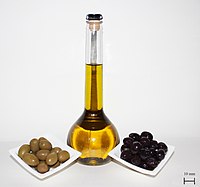
Photo from wikipedia
The aim of the present study was to differentiate sensory good and bad virgin rapeseed oils based on the composition of the volatile compounds by means of linear discriminant analysis… Click to show full abstract
The aim of the present study was to differentiate sensory good and bad virgin rapeseed oils based on the composition of the volatile compounds by means of linear discriminant analysis (LDA). A total number of 64 compounds were detected by dynamic headspace GC-MS and combined olfactometry with potential for sensory quality assessment either as aroma-active compound by substance concentration or flavor property or as a non-aroma-active compound by correlation with the panel assessment. From this initial set of substances, 13 volatile compounds showed significant differences in the concentration between sensory good and bad oils, whereas their concentration was higher in sensory bad oils. No significant differences were found for compounds characterizing sensory good virgin rapeseed oils. Based on these 13 volatile compounds, the present work shows for the first time that LDA was able to classify a training data set of 43 samples satisfactorily according to the sensory quality. As a proof for suitability, a discriminant function was calculated and successfully used to classify samples from an additional validation sample set. Practical applications: Virgin rapeseed oils are high-quality products on the market, which are defined above all by their sensory quality. The sensory evaluation of virgin rapeseed oils by a trained sensory panel group is time and labor consuming and sometimes the results are not reliable. Therefore, the development of an analytical method for the discrimination of sensory good and bad virgin rapeseed oils based on the determination and statistical evaluation of volatile, aroma-active compounds is a helpful tool to support the sensory evaluation. The repeatability of the analytical method is better than the sensory evaluation, which also helps to support the work of a panel group. Additionally, the amount of work for a panel group can be reduced due to a pre-selection by the analytical tool. The present work shows a chemometric approach to differentiate sensory good and bad quality virgin rapeseed oils on basis of 13 volatile compounds. For the first time volatile compounds have been identified that can be correlated with sensory bad virgin rapeseed oils.
Journal Title: European Journal of Lipid Science and Technology
Year Published: 2017
Link to full text (if available)
Share on Social Media: Sign Up to like & get
recommendations!